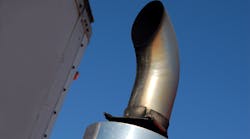How fleets can reduce their carbon footprint without EVs
With stronger pollution standards on the horizon from the Environmental Protection Agency and California proposing stricter emissions requirements, fleets are feeling the push to integrate electric vehicles (EVs), even before they’re ready to do so. Meanwhile, EVs themselves come with a bevy of requirements and challenges, ranging from how to adjust for weight limitations with heavier vehicles to planning for the necessary charging infrastructure.
Because of these challenges, Craig Marris, chief sustainability officer (CSO) for EROAD, a fleet management platform, anticipates that for the next 15-20 years, fleets may need to depend more on transitional diesel strategies to lower their emissions than electric vehicles.
Read more: Early adopter fleet opens up about EV range, charging in real world“A big part of that is recognizing, ‘Okay, I've got these older vehicles, how do I run those as optimally as I can as I work through this transition?'” Marris said in an interview with Fleet Maintenance.
Maintenance strategies
To help a diesel engine lower its emissions, one of the first tasks in any maintenance department is to ensure the engine is well taken care of. Dirty filters and sparkplug issues are all liable to increase a vehicle’s particulate output, making them one of the first items to check during preventive maintenance. However, Marris also emphasized that it’s critical to understand fuel systems.
“If you've got leaking fuel injectors, you can run with rich fuel, which means you're emitting a lot more carbon emissions,” Marris said. “Even exhaust leaks are a big deal.”
Then, of course, maintenance must ensure that a diesel vehicle’s aftertreatment system is working properly, including checking the catalytic converter and ensuring that all sensors are calibrated.
When seeking out problems in a diesel engine’s emission controls, one element to watch for is a sudden, sustained drop in miles-per-gallon, Marris noted.
“When you see your MPGs suddenly drop but your driver behavior is pretty much the same, that's always a leading indicator that something really serious is potentially going to happen to your tractor,” the CSO explained.
As an example, if a Class 8 vehicle typically gets 9 MPGs and then suddenly drops to 4.5, that could indicate that something is wrong with the exhaust gas recirculation sensor, such as an EGR valve failure. This, then, can cause issues with particulate buildup, creating further problems both upstream and downstream of the sensor.
With the cascading effects of a single problem in the aftertreatment system, telematics and data are more important than ever for diesel fleets working to curb their emissions, Marris emphasized, as these insights show how several elements can combine to cause larger issues.
Equipment
Maintenance teams can also help their diesel engines meet fleet emission goals by using the best equipment at their disposal and tailoring their preventative maintenance. For instance, Marris asserted that synthetic engine oils can make a large difference in terms of a diesel truck’s emissions.
“I know that for a fact because I worked in Exxon Mobil for 14 years,” Marris explained. “It does have a huge difference because the synthetic oil can handle high temperatures so you don’t have to change it so much, and it's removing the dirty particulate.”
Meanwhile, replacing diesel engine oil at the right time can go a long way toward keeping emissions down as well. But calculating these intervals may not be as simple as going with the manufacturer's recommendation; instead, Marris advised that fleets keep in mind the specificities of their operation and regional area.
“I would say to fleets that what they've got to do is take the manufacturer spec, but then look at the usage, look at the environment, and even the seasonal elements around a fleet,” the CSO said. “And then I would do a correlation between the make, year, model, and what fault codes you’re seeing when you look a historical metadata.”
By examining all of these factors, a maintenance team might find they need to schedule equipment changes at a higher or lower rate than the manufacturer suggests. Then, using a fleet maintenance platform, they can apply these findings to the other vehicles in their fleet that share the same parameters.
Results
With these practices, a fleet does not have to transition to electric vehicles before they’re ready to make strides on their emissions goals. By only changing their behavior, Marris estimated that a fleet can achieve double-digit improvements in their emissions.
For a previous client, Marris described how in emulating these habits, “safety improved, MPGs improved massively, and maintenance costs came down. All of which has an effect on emissions.”




